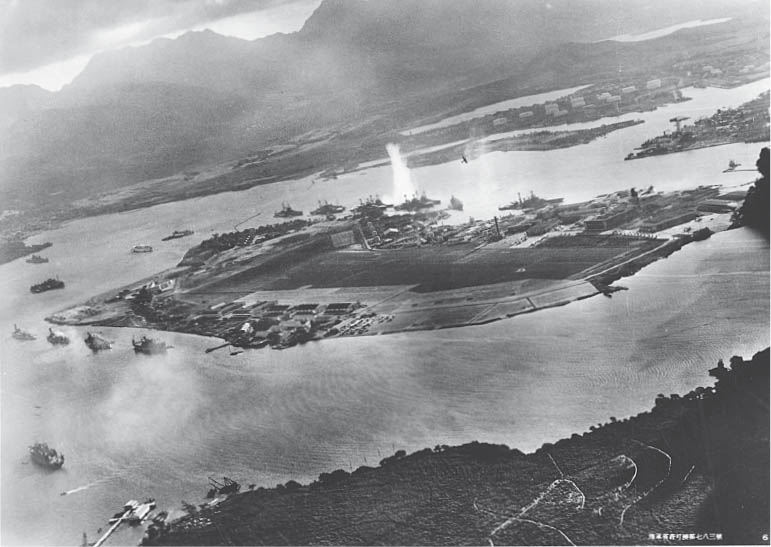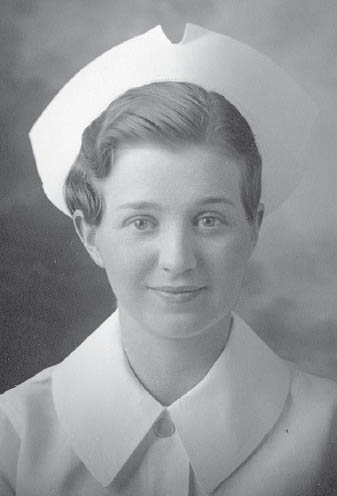
A LONG WAY FROM HOME
Ruth Erickson was four thousand miles from her hometown of Virginia, Minnesota, when fighter planes began bombing the naval base where she was stationed. That Sunday morning, still in her housecoat and curlers, she was having a quiet breakfast in the dining room with three other nurses. Ruth had plans to picnic with friends later in the day on the other side of the island. While she and the nurses were talking, they heard the deep hum of planes coming in close and assumed pilots were doing extra reserve flying. When they started to hear noise that sounded like shooting, Ruth went into the corridor to look out a window. She saw a plane with a large rising sun insignia fly by low, so low that if Ruth had known the pilot, she could have recognized him through his goggles and called him by name. Fortunately, he passed by, presumably looking for a more significant target. A few moments later, shortly before 8:00 AM on December 7, 1941, the attack on Pearl Harbor began.

View of Pearl Harbor taken by an Imperial Japanese pilot in the first minutes of the attack on December 7, 1941. US Navy NH 50930, courtesy of the Naval History and Heritage Command
Ruth ran to her room, pulling out her pin curls along the way. Phones began ringing, and the chief nurse yelled, “Girls, get in your uniforms at once! This is the real thing!” After quickly dressing, Ruth dashed across the street through a shower of shrapnel. Her sense of purpose carried her as far as the lanai, a screened porch outside the administrative section of the navy hospital. Once she stopped, she froze, unable to move until an inner voice told her to get going! She ran to the orthopedic dressing room but found it locked. She shouted to a corpsman to get the keys. It seemed to take him forever to return and open the door. By then, several nurses had arrived, and they began to prepare for possible casualties. Little did they know 2,403 servicemen would die and 1,143 would be injured that day. The first casualty arrived at 8:25 AM.
· · · · ·
Ruth Erickson, the oldest of five children, was born in 1913 in the town of Virginia in northern Minnesota to Swedish and Norwegian American parents. Her hometown, in a region once inhabited by the Ojibwe, rests on an ancient mountain range, the Mesabi, which was leveled by two massive glaciers in prehistoric times, exposing mineral ore and paving a path for vast, fertile pine forests. Mining and lumbering industries boomed during Ruth’s childhood. Iron ore and timber were transported by train to Lake Superior, only sixty miles away, for export around the world. Ruth’s father was a deputy sheriff and her mother was a homemaker.
At Roosevelt High School, Ruth played flute in orchestra and band, and she was chair of the senior sewing club. In her high school yearbook, she was described as “a blue-eyed optimist viewing life through rose-colored glasses—Pipes of Pan smiling through good fortune or bad.” By the time of Ruth’s graduation in 1931, the lumber industry had started moving west, where the trees were larger and closer together, and many of the mines had been exhausted. The impact of the Great Depression further squelched opportunity in Virginia. Economic growth stopped, and the population of the once-booming town dropped 15 percent between 1920 and 1930. Jobs were scarce. Ruth decided it was a good time to see more of the world, so she entered the Kahler School of Nursing in Rochester, Minnesota, affiliated with the renowned Mayo Clinic medical practice. After three years of nursing school, she worked in hospitals, caring for Mayo Clinic patients with a wide range of conditions: goiters, hernias, diabetes, and epilepsy.
As the world came to Ruth through the international clientele of the Mayo practice, she realized she “had adventure in her soul” and wanted to see more. Ruth decided to follow friends of hers who had joined the Veterans Administration. During the physical examination that was part of the application process, a Mayo Clinic physician asked her, “What do you want to be interested in the Veterans Administration for? That’s a political setup.” He encouraged her to consider nursing in the military instead, and put her in touch with a navy physician who happened to be at Mayo Clinic working in aviation medicine. Dr. Joe White told Ruth she could see the Philippines, Hawaii, and the Caribbean with the navy, which sounded pretty good to a restless twenty-three-year-old woman in Minnesota.
Ruth applied to the Navy Nurse Corps, and after being accepted and going home to visit her parents and siblings, on July 27, 1936, she found herself on her way to US Naval Base San Diego, watching through the train window as palm trees and a desert landscape passed by. Her first assignment was on the USS Relief, a 550-bed hospital vessel. Aboard this ship for the next three years, Ruth traveled to the Mediterranean, Jamaica, and Haiti.

Ruth Erickson, Kahler School of Nursing, 1934. Used with permission of Mayo Foundation for Medical Education and Research. All rights reserved.
In 1939, after finishing five days of R & R on the beaches of Charlotte Amalie in the Virgin Islands, the crew of the USS Relief headed for their next assignment, helping set up for the World’s Fair in New York City, slated to open in April. But threats from Japan were mounting, and all navy ships were ordered back to the West Coast. The USS Relief conducted routine maneuvers along the coast and into the Pacific Ocean along the Honolulu chain of islands.
In May 1940, Ruth was sent to US Naval Hospital Pearl Harbor. She and seven other nurses assigned there enjoyed a posh, tropical lifestyle. The nursing quarters were comfortable, and they felt almost spoiled by the regular supply of iced tea and fresh pineapple. Most of the servicemen on the base were young and healthy and avoided the hospital, so the workload was light. The sailors occasionally came down with “cat fever,” or catarrhal fever, a viral respiratory infection. Some servicemen required minor surgeries—appendectomies, hernia repairs, and tonsillectomies. In their off-hours, the nurses enjoyed playing tennis, swimming at the beach, and picnicking throughout the island. They dated aviators attached to the base and found themselves dancing under starlit skies at the Royal Hawaiian Hotel in Waikiki. It was a pretty good assignment until December 7, 1941.
· · · · ·
The first serviceman brought into the unit was bleeding profusely from an abdominal gunshot wound. The medical team, shaking in fear, managed to start an IV on him. By 8:10, the USS Arizona was hit by an armor-piercing shell and began sinking, taking with it eleven hundred lives. As the USS Arizona was sinking, the USS Nevada attempted to pull out of the channel when it was hit and went aground near the hospital. The men were ordered to dive off and swim to shore, but the thick oil on the water ignited, and they found themselves swimming through fire. Their tropical uniforms, t-shirts and shorts, provided little protection, and their exposed skin burned as they swam through the flames; they arrived on the shores badly injured.
Just as the first patient, who had been bleeding badly, died, burn victims began streaming in. The hospital staff had to be innovative. In a storage unit, they found small hand pumps intended for spraying insecticide. They filled the pumps with tannic acid and sprayed the burned sailors. They hoped the tannic acid, with its strong antimicrobial impact, would reduce mortality rates.
The air was thick with smoke, and the medical team worked with flashlights as evening came. Anyone who could manage a hammer was helping to cover windows with black drapes or paper to prevent light from seeping out. Around 10 or 11 o’clock that evening, they heard planes heading toward them again. Ruth’s knees were knocking and patients were calling out in fear. The priest went from bed to bed trying to comfort the injured and frightened sailors. When the noise ended, they realized the sounds had come from US, not enemy, planes.
When it was her turn to take a break, Ruth went to the basement of the hospital, where the staff and some of their families were brought that night. No one got much sleep.
For a week and a half, Ruth and the medical team took care of patients as best they could. On the evening of December 17, the chief nurse told Ruth to pack a bag and be ready to leave at noon the next day. When Ruth asked where she was being sent, the chief nurse said she had no idea. The commanding officer asked for three nurses to be ready to leave in uniform. So Ruth and two others, dressed in their white uniforms, blue capes, and felt hats, were picked up by a car and taken to get their orders. They learned they were going aboard the SS President Coolidge, a steamship, to escort 125 wounded sailors back to a base on the mainland. Patients needing more than three months to recover were being relocated.
The journey was trying. The waters were rough and tensions were high. The steamship was part of a caravan carrying navy patients, missionaries, and countless others who were evacuating the area now considered a war zone. The vessels traveled without exterior lights. At one point, a rumor circulated that they were being followed by an enemy submarine. They arrived in San Francisco Christmas morning. Ruth and her colleagues were cheered to see the Red Cross serving donuts and coffee. They transferred their patients to ambulances that took them to the naval hospital at Mare Island and several nearby civilian hospitals.
By December 27, Ruth and the other nurses had settled all of the patients in their new hospitals, and they were ordered to return to Pearl Harbor on the USS Henderson, part of a huge influx of ten thousand troops into the Pacific theater. Ruth remained at Pearl Harbor working in the naval hospital until July 1942, when she was transferred to the base at Corona, California. By then she was six years into what would become a twenty-six-year career in the navy, which would take her around the world. Eventually she would be known as Captain Ruth Erickson, director of the US Naval Nurse Corps, a position that was later given admiral rank.
· · · · ·
Ruth was not the only woman from the Virginia, Minnesota, area, often called the Iron Range, to serve in the military during World War II. More than three hundred women from this region alone and many more from throughout Minnesota left their hometowns to join the Navy and Army Nurse Corps, Marine Reserves, Women’s Army Auxiliary Corps (WAAC), Women’s Army Corps (WAC), Women Accepted for Volunteer Emergency Service in the Navy (WAVES), women’s Coast Guard reserve Semper Paratus, Always Ready (SPAR), Women Airforce Service Pilots (WASP), and various state and local reserve units. They also entered the workforce in a wide range of industries in addition to making significant contributions in communities and at home during the ominous and crucial years of World War II. They demonstrated abilities to work as well as, if not better than, men in some fields, a realization that would have long-reaching implications for how women were viewed in the decades following the war.